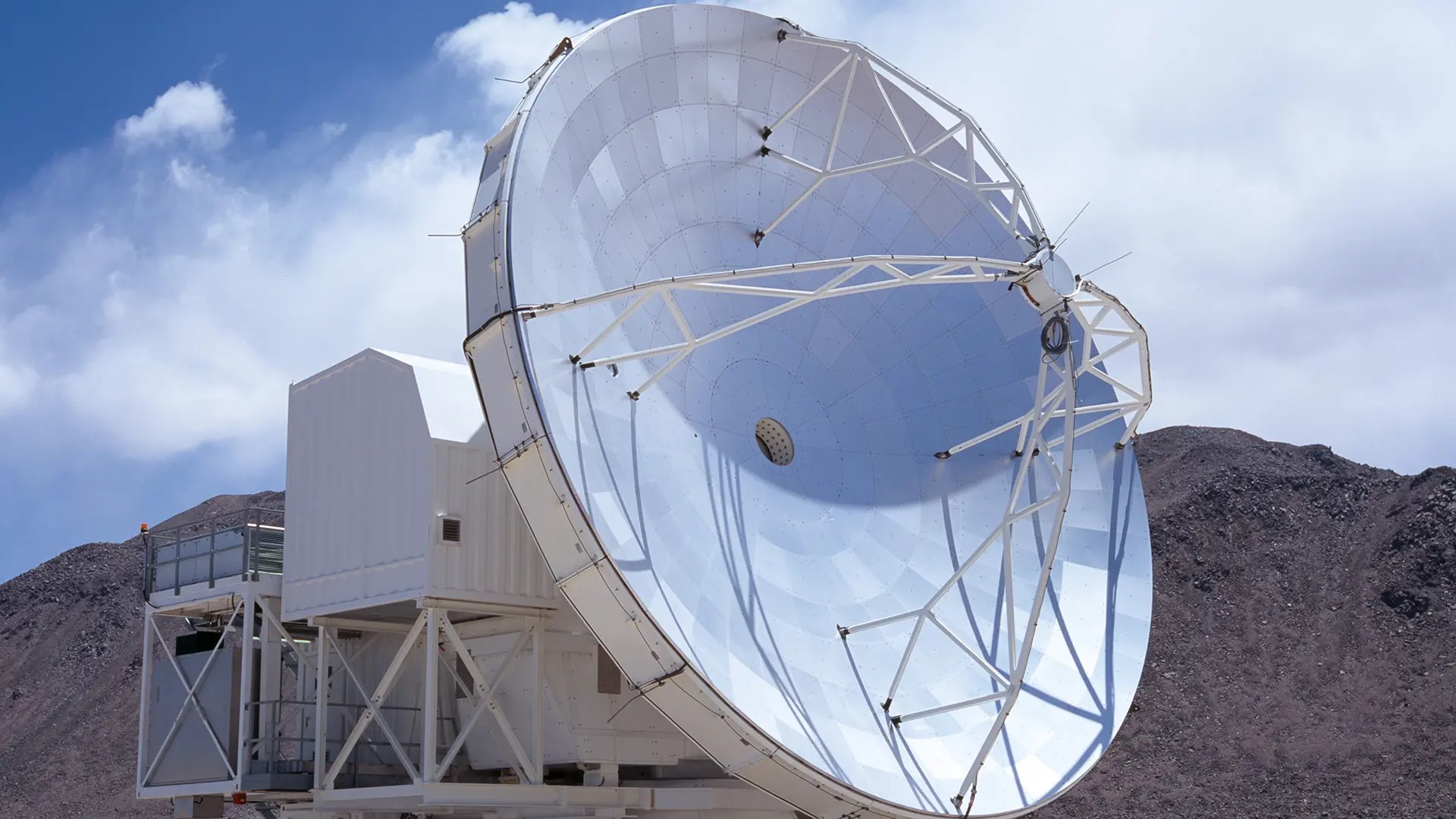
APEX. Credit: ESO
APEX, the Atacama Pathfinder EXperiment, is a 12 m diameter submillimetre telescope at 5100 m altitude on Llano Chajnantor in Chile. Starting in 2023, the APEX telescope is operated solely by Max-Planck-Institut für Radioastronomie (MPIfR).
About APEX
- APEX provides almost unique opportunities for astronomers to use submillimetre observations to study the first galaxies and how stars and planets are formed.
- The APEX project was a collaboration between Onsala Space Observatory, Max Planck Institut für Radioastronomie (Germany), and the European Southern Observatory to construct and operate a modified ALMA prototype antenna as a single dish on the high altitude site of Llano Chajnantor. The telescope was supplied by VERTEX Antennentechnik in Germany.
- Starting in 2023, the APEX telescope is operated solely by Max-Planck-Institut für Radioastronomie (MPIfR). However, the Onsala Space Observatory continues to support APEX and in return PI:s with a Swedish affiliation have access to APEX observing time.
- Onsala Space Observatory, through the Group for Advanced Receiver Development (GARD), provides heterodyne receivers for APEX.
- The receiver SEPIA (Swedish ESO PI receiver for Apex) was installed in 2015. It includes channels for ALMA Band 5 (159-211 GHz), ALMA Band 7 (272-376 GHz), and ALMA Band 9 (600-722 GHz).
- The Swedish Heterodyne Facility Instrument, SHFI, covered several frequency bands up to 1.3 THz. SHFI was decommissioned in 2017.
- APEX was inaugurated in September 2005
Scientific publications containing APEX data
In scientific publications containing APEX data please:
- Acknowledge the project with one of the following footnotes. For APEX observations on Swedish time made after 1 January 2021: "Based on observations with the Atacama Pathfinder EXperiment (APEX) telescope, operated by the Max Planck Institute for Radio Astronomy. Swedish observations on APEX are supported through Swedish Research Council grant No 2019-00208". For APEX observations on Swedish time made before 1 January 2021: "Based on observations with the Atacama Pathfinder EXperiment (APEX) telescope. APEX is a collaboration between the Max Planck Institute for Radio Astronomy, the European Southern Observatory, and the Onsala Space Observatory. Swedish observations on APEX are supported through Swedish Research Council grant No 2017-00648".
- Give the project ID for the observations.
- Give proper references to papers about the telescope and receiver(s). Use the following references to instrumentation papers:
The APEX telescope:
The Atacama Pathfinder EXperiment (APEX) – a new submillimeter facility for southern skies –
R. Güsten, L. Å. Nyman, P. Schilke et al.
A&A 454, L13–L16 (2006)
doi: 10.1051/0004-6361:20065420
SHFI (Swedish heterodyne Facility Instrument):
A Swedish heterodyne facility instrument for the APEX telescope
Vassilev, V.; Meledin, D.; Lapkin, I. et al.
A&A 490, 1157–1163 (2008)
doi: 10.1051/0004-6361:200810459
Heterodyne single-pixel facility instrumentation for the APEX Telescope
Victor Belitsky; Igor Lapkin; Raquel Monje et al.
Proc. SPIE 6275, Millimeter and Submillimeter Detectors and Instrumentation for Astronomy III, 62750G (2006)
doi: 10.1117/12.671383
SEPIA (Swedish ESO PI receiver for Apex):
SEPIA - a new single pixel receiver at the APEX Telescope
V. Belitsky, I. Lapkin, M. Fredrixon, et al.
A&A 612, A23 (2018)
doi: 10.1051/0004-6361/201731458
Band 5:
ALMA Band 5 receiver cartridge. Design, performance, and commissioning
V. Belitsky, M. Bylund, V. Desmaris et al.
A&A 611, A98 (2018)
doi: 10.1051/0004-6361/201731883
Band 7:
SEPIA345: A 345 GHz dual polarization heterodyne receiver channel for SEPIA at the APEX telescope
D. Meledin, I. Lapkin, M. Fredrixon et al.
A&A 668, A2 (2022)
doi: 10.1051/0004-6361/202244211
Band 9:
The ALMA Band 9 receiver. Design, construction, characterization and first light
A. M. Baryshev, R. Hesper, F. P. Mena et al.
A&A 577, A129 (2015)
doi: 10.1051/0004-6361/201425529
See the APEX web site for references to papers about other instruments.
Contact
Per Bergman
- Senior Research Engineer, Onsala Space Observatory, Space, Earth and Environment
